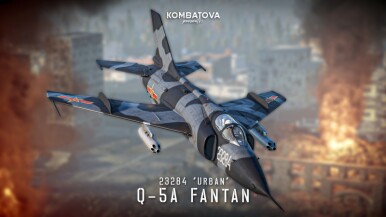



The Q-5A (known as Q-5I pre-1987, 强-5A/强-5I型强击机; unified NATO codename: Fantan) was the main production variant of Q-5 series attacker in the first half of 1980s. During the production of the Q-5 early, PLAAF suggested for improvements to Q-5 especially in terms of its combat radius in 1976; Factory 320 (NAMC) soon concretized the required improvements including new internal fuel tanks, new engines, relocated drag chute and revised lifesaving equipment. Test flights were done during 1979 to 1980 with overall improved performance and was certified in 1983; however, engineers also called for another variant that introduced electronic improvements with new RWR and countermeasures, as well as new optical sights, the new jet, known as Q-5IA (Q-5B post-1987) was set as the standards of future productions of Q-5 before the Q-5II (Q-5C post-1987) overtook the production by 1986.
Introduced in Update "New Power", Q-5A is externally very similar to the Q-5 early aside from the pure white paint scheme. This variant has several new features: it now has flares, a radar warning receiver, a ballistic computer, and a new pair of hardpoints for mounting 130 mm high-explosive rockets. The flight performance has also been improved noticeably, courtesy of the more powerful engines. The Q-5A is an all-round improvement with enhanced self-defense in air combat and much higher efficacy in ground attack; with the Q-5IA upgrades, it further enhance the survivability of Q-5A thanks to the countermeasures and RWR onboard.
flaps
flaps
flaps
brake
| Belt | Belt filling | Armor penetration (mm) at a distance: | |||||
|---|---|---|---|---|---|---|---|
| 10 m | 100 m | 500 m | 1000 m | 1500 m | 2000 m | ||
| AP-I/HEF-I | 31 | 29 | 20 | 13 | 8 | 6 | |
| HEF-I/AP-I/AP-I/AP-I | 31 | 29 | 20 | 13 | 8 | 6 | |
| HEF-I/HEF-I/HEF-I/AP-I | 31 | 29 | 20 | 13 | 8 | 6 | |
| AP-I | 31 | 29 | 20 | 13 | 8 | 6 | |
| Name | Weight | Slot | ||||
|---|---|---|---|---|---|---|
| 4 × | 235.3 kg |  |  | |||
| 7 × | 153.5 kg |  |  | |||
| 4 × | 947.7 kg |  | ||||
| 4 × | 866 kg |  | ||||
| 4 × | 960 kg |  | ||||
| 4 × | 540 kg |  | ||||












Flight performance | |
|---|---|
Survivability |
|---|
Weaponry | ||
|---|---|---|
